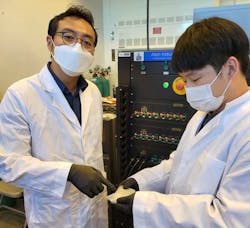Solid Rubber Electrolyte May Solve Li-Battery Problems
Researchers at the Georgia Institute of Technology have developed a promising new electrolyte from rubber for Li-ion batteries that could lead to electric vehicles becoming safer and more popular with consumers.
In lithium-ion batteries, ions moved through liquid electrolytes. However, thee make the batteries inherently unstable, and the slightest damage can lead to explosions or fires.
The Georgia Tech team explored elastomers, or synthetic rubbers, which are widely used in wearable electronics and soft robotics because of their superior mechanical properties. The researchers found that when they used the material in an engineered 3D structure, it let Li-ions move quickly through while it retained its mechanical toughness. This resulted in longer charging solid-state batteries that can go farther.
“Most of the industry is focusing on building inorganic solid-state electrolytes. But they are hard to make, expensive and are not environmentally friendly,” says Seung Woo Lee, an associate professor on the team. “Solid polymer electrolytes continue to attract great interest because of their low manufacturing cost, non-toxicity and soft nature. However, conventional polymer electrolytes do not have the ionic conductivity and mechanical stability for reliable operation of solid-state batteries.”
The team’s key breakthrough was getting the rubber to form a 3D interconnected plastic crystal phase within the larger rubber matrix. This structure has high ionic conductivity, better mechanical properties and electrochemical stability. This rubber electrolyte can be made using a simple low-temperature polymerization process and leaves strong and smooth interfaces on the surface of electrodes. This prevents lithium dendrite growth and allow for faster moving ions letting the solid-state battery operate reliably even at room temperatures.
“Rubber has been used everywhere because of its high mechanical properties, and it will let us make inexpensive, more reliable and safer batteries,” says Lee.
“Higher ionic conductivity means you can move more ions at the same time,” adds Michael Lee, a mechanical engineering researcher. “By increasing specific energy and energy density of these batteries, we can increase the mileage of the EVs.”
The team is now looking at ways to improve the battery performance by increasing its cycle time and decreasing the charging time through even better ionic conductivity. So far, their efforts have doubled the battery’s performance and cycle times
SK Innovation, an energy and petrochemical company, is funding additional research of the rubber electrolyte as part of its work with Georgia Tech to build next-generation solid-state batteries that are safer and more energy-dense than conventional LI-ion batteries. The global firm recently announced they would build an EV battery plant in Commerce, Ga., expected to annually turn out lithium-ion batteries equal to 21.5 Gigawatt-hours by 2023.

